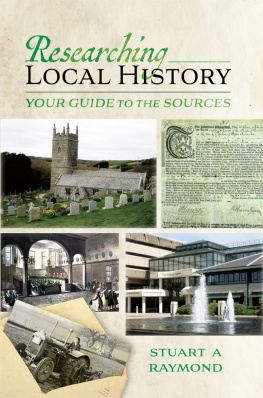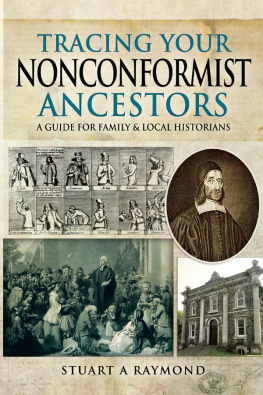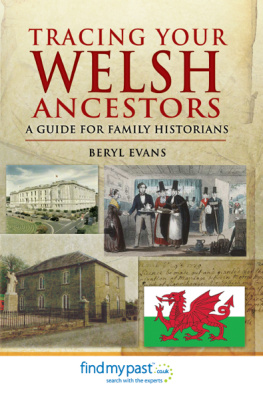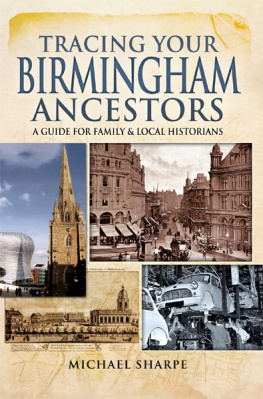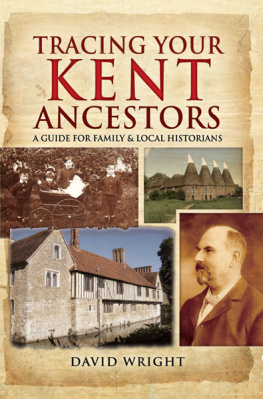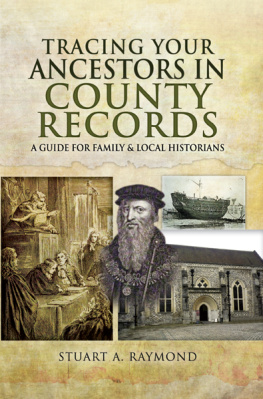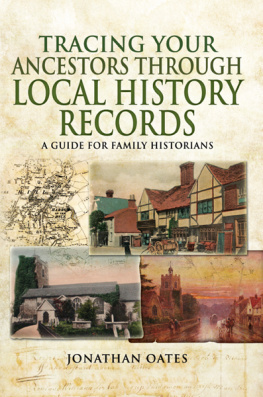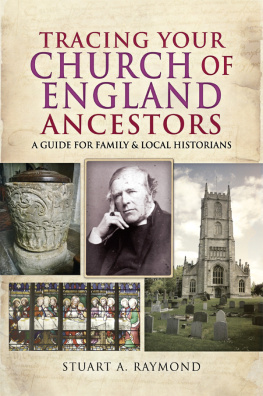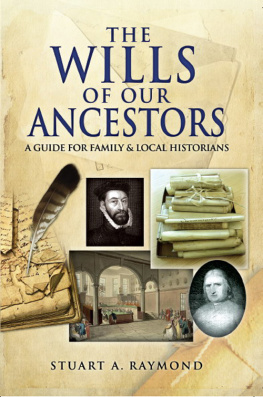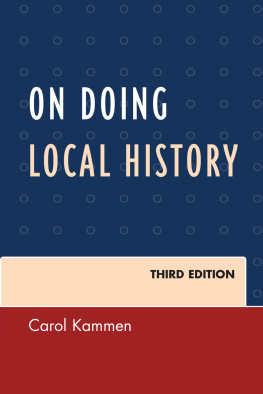Pagebreaks of the print version

RESEARCHING LOCAL HISTORY
YOUR GUIDE TO THE SOURCES
RESEARCHING LOCAL HISTORY
YOUR GUIDE TO THE SOURCES
STUART A. RAYMOND
First published in Great Britain in 2022 by
PEN AND SWORD FAMILY HISTORY
An imprint of Pen & Sword Books Ltd
Yorkshire Philadelphia
Copyright Stuart A. Raymond, 2022
ISBN 978 1 52677 942 7
eISBN 978 1 52677 943 4
Mobi ISBN 978 1 52677 943 4
The right of Stuart A. Raymond to be identified as Author of this work has been asserted by him in accordance with the Copyright, Designs and Patents Act 1988.
A CIP catalogue record for this book is available from the British Library
All rights reserved. No part of this book may be reproduced or transmitted in any form or by any means, electronic or mechanical including photocopying, recording or by any information storage and retrieval system, without permission from the Publisher in writing.
Pen & Sword Books Ltd incorporates the Imprints of Aviation, Atlas, Family History, Fiction, Maritime, Military, Discovery, Politics, History, Archaeology, Select, Wharncliffe Local History, Wharncliffe True Crime, Military Classics, Wharncliffe Transport, Leo Cooper, The Praetorian Press, Remember When, Seaforth Publishing and Frontline Publishing.
For a complete list of Pen & Sword titles please contact
PEN & SWORD BOOKS LTD
47 Church Street, Barnsley, South Yorkshire, S70 2AS, England
E-mail:
Website: www.pen-and-sword.co.uk
Or
PEN & SWORD BOOKS
1950 Lawrence Rd, Havertown, PA 19083, USA
E-mail:
Website: www.penandswordbooks.com
INTRODUCTION
W hen I began to study English local history back in the 1970s, I was inspired by W.G Hoskins Local History in England . I soon, however, realised that I needed more information on sources than Hoskins provided, and turned to W.B. Stephens Sources for English local history . Both of these books are still useful, but they badly need updating (especially Stephens). Many more source materials have become easily available in the last few decades. Stephens did not even mention Lloyd Georges valuation survey, one of the key sources for early twentieth-century history. The internet now enables me to easily read millions of probate records from the comfort of my own study. A huge range of other sources have been digitised for the internet, so much so that it is easy to forget that a much wider range of sources lying on record office shelves remain undigitised.
The aim of this book is to make the English local historian aware of the wide range of written sources available in record offices, libraries and on the internet. Like Stephens book, its aim is to pose the questions which ought to be asked, and then to identify the specific sources which are likely to answer those questions. I have attempted to explain how and why particular sources were created, the uses to which they can be put, and the limitations of the information they provide.
In a book of this length, it is not possible to deal with all the sources and topics that might be of interest to local historians. Nor is it possible to provide the detail that might be thought desirable. That detail is, however, provided in the numerous guides (many online) to specific sources that I have cited. I have tended to concentrate on sources relevant to parish history, although not, I hope, entirely neglecting the wider context. Some topics, for example, prisons, military history, political history, witchcraft, prices and wages, and oral history, landscape history, have been barely mentioned or dealt with cursorily. Archaeology is very important to local historians, but only very rarely is it likely to provide written sources. For other topics, of course, there is a paucity of sources. The further back in time you go, the fewer written sources are likely to be available.
ACKNOWLEDGEMENTS
T his book is entirely dependent on countless local historians, and especially those whose works it cites. My thanks to them, to the librarians at Trowbridge library who obtained many of their publications for me, and to those who read my manuscript in draft. One of my former Pharos students and Simon Fowler have both made useful suggestions and saved me from errors. My thanks too to my wife Marjorie, who drags me away from the computer when I have been staring at the screen too long.
A Note on Counties
The counties mentioned in this book are those which existed before the 1974 local government reforms.
ABBREVIATIONS
| FFHS | Federation of Family History Societies (now Family History Federation). |
| Short Guides 1 . | Munby, Lionel, ed. Short Guides to Records . Historical Association, 1972; |
| Short Guides 2 . | Thompson, K.M. Short Guides to Records. Second Series, guides 2548. Historical Association, 1997. |
| TNA | The National Archives |
| VCH | Victoria County History |
Chapter 1
WHAT IS LOCAL HISTORY?
H istory is a seamless web. Local historians are frequently concerned with family history, economic history, social history, or religious history. A good knowledge of English history, and indeed, British, European and worldwide history, is needed by anyone who wishes to research the local history of England and Wales. English history is the history of some 12,000+ parishes, and of how they relate to each other. Urban history is also important. Local historians may know their own localities best, but nevertheless need to know about Domesday Book , the plague, the Reformation, Royalists and Parliamentarians, nonconformists, the British Empire, the census, and the Home Front in two world wars.
Local history has a dual focus. It is local, focused on a specific place. It is history, focused on people, and on their communities. The place may be a parish, a town, or some larger region. It is likely to be in a rural area, as that is where most people lived prior to 1851.
Some places have had a continuous existence for thousands of years. That applies to many mentioned in Domesday Book . At that time, the manor was probably the most important institution in peoples lives, and provided their sense of identity. However, its importance even then was in decline, as local churches were being built. These churches served specific areas, known as parishes. Parish boundaries were established between c .900 and c .1200, and determined where people attended church. Attendance at church defined communities for most of the last millennium, hence the importance of the parish, and of its church as the hub of the community.
Parish boundaries were not, however, confining. Most people crossed them regularly. The relationship between local communities and the region was important. Markets and fairs catered for regions, not for just one parish. Blacksmiths needed coal mined in Newcastle. Farmers needed to sell their wool at Blackwell Hall in London. Young men found their brides in neighbouring parishes. Vagrants travelled hundreds of miles in search of work, or, at least, subsistence. Trade and industry relied on transport links. The local historian must examine sources created in places other than his own parish. Parish registers and pauper records of neighbouring parishes sometimes provide useful information. The apprenticeship records of London companies identify apprentices from most English parishes. Probate records identify family members and creditors who lived at great distances from their relatives and debtors.

